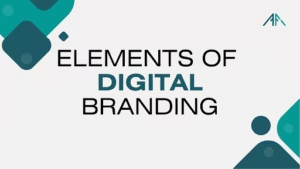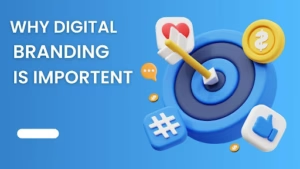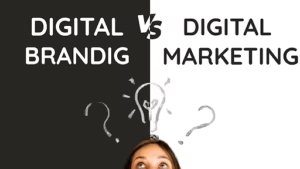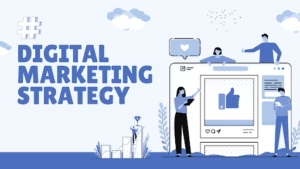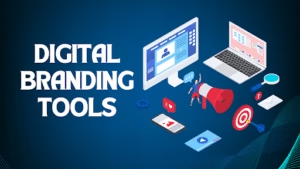Introduction: Why Digital Branding Matters Today
In today’s hyperconnected world, businesses no longer thrive solely on physical presence or traditional marketing. Consumers live online—scrolling, sharing, and shopping. That’s where digital branding becomes the key to building trust, visibility, and long-term success.
Digital branding encompasses a company’s whole online identity, not just its logo or website. From social media voice to website design, from search engine visibility to customer interactions, digital branding defines how an audience perceives and engages with a brand in the digital space.
If you’re building a startup, scaling a business, or rethinking your marketing strategy, mastering digital branding is no longer optional—it’s essential.
What is Digital Branding?
Digital branding refers to the strategic process of creating, communicating, and managing a brand’s online identity. It goes beyond visual elements like colors and logos. Instead, it blends marketing, design, content, and user experience to create a consistent brand presence across digital channels.
In simpler terms, digital branding answers these questions:
- How do customers recognize your brand online?
- What emotions does your brand evoke digitally?
- How consistent is your message across different platforms?
When executed well, digital branding builds trust, drives engagement, and ensures brand loyalty in the digital age.
The Core Elements of Digital Branding
Successful digital branding is built on several interconnected elements. Let’s break them down:
1. Brand Identity
Your brand identity is the foundation. It includes your logo, typography, colors, and brand guidelines that create a cohesive look and feel across digital platforms.
2. Website Presence
A polished, user-friendly website is often the first impression you make on potential customers.
3. Content Strategy
Content is the heart of digital branding. From blogs and videos to social media posts and newsletters, content communicates your voice and values.
4. Social Media
Your social media presence humanizes your brand. Consistency in tone, visuals, and engagement builds trust and community.
5. SEO & Online Visibility
No matter how beautiful your brand looks, if it doesn’t show up in search engines, it’s invisible. SEO makes your brand discoverable.
6. Customer Experience (CX)
Digital branding also relies on how customers feel during interactions. Fast responses, easy navigation, and personalized experiences shape brand perception.
Why Digital Branding is Important
Brands that invest in digital branding enjoy several benefits:
- Increased Visibility: Elevates your brand above the competition.
- Stronger Customer Trust: Consistent digital presence builds credibility.
- Higher Engagement: Good branding encourages likes, shares, and interaction.
- Better Conversions: Customers buy from brands they recognize and trust.
- Long-Term Loyalty: Emotional connection leads to repeat purchases.
Think about companies like Apple, Nike, and Starbucks. Their digital branding is so strong that customers instantly recognize and trust them online.
Digital Branding vs. Digital Marketing
While many confuse digital branding with digital marketing, they’re not the same
- Digital Branding is about building identity and recognition. It answers “Who are we as a brand?”
- Digital Marketing is about promoting products/services and generating leads. It answers “How do we sell effectively?”
Branding sets the stage; marketing makes it perform.
Steps to Build a Strong Digital Branding Strategy
1. Define Your Brand Purpose and Values
Before creating visuals or running campaigns, define your “why.” Ask:
- What problem does my brand solve?
- What values guide my business?
- How do I want customers to feel?
2. Develop a Consistent Visual Identity
Choose your logo, brand colors, fonts, and style guides that represent your personality.
3. Build a High-Impact Website
Your website should be fast, responsive, and optimized for mobile. It must clearly communicate your value proposition.
4. Create Valuable Content
Start a blog, produce videos, write guides, or host webinars. Inspiring, educating, and engaging are the objectives.
5. Leverage Social Media
Pick platforms where your audience is active. Post regularly, engage authentically, and use consistent branding.
6. Focus on SEO
Optimize your website and content with keywords, metadata, and backlinks. The more searchable you are, the stronger your brand presence.
7. Monitor & Evolve
Use tools like Google Analytics, SEMrush, or social media insights to track performance. Refine your strategy based on real-time feedback.
Best Digital Branding Tools
Here are some popular tools that simplify the digital branding journey:
- Canva – for designing visuals and social media content.
- WordPress – for building professional websites.
- SEMrush / Ahrefs – for SEO optimization.
- Hootsuite / Buffer – for managing social media.
- Mailchimp – for email marketing campaigns.
- Google Analytics – for tracking website performance.
Case Studies: Digital Branding Done Right
Apple
Apple’s minimalistic design, consistent messaging, and innovative campaigns make it one of the most powerful digitally branded companies in the world.
Nike
Nike uses storytelling (“Just Do It”) and inspirational content to connect emotionally with its audience.
Coca-Cola
Coca-Cola leverages personalization (“Share a Coke”) and emotional advertising to strengthen digital brand identity.
Common Mistakes in Digital Branding
Even big brands make errors. Here are mistakes to avoid:
- Inconsistent branding across platforms.
- Ignoring customer feedback.
- Overcomplicated logos or designs.
- Not optimizing for mobile users.
- Focusing only on sales instead of building trust.

Future of Digital Branding
As technology evolves, so does branding. Businesses can no longer rely on static strategies because the digital landscape is dynamic and constantly shifting. Emerging technologies, changing consumer expectations, and global trends are shaping the future of digital branding in powerful ways. Brands that adapt early will stay ahead of the competition, while those that resist change risk fading into obscurity.
Here are some of the most important future trends to watch in digital branding:
AI-Driven Personalization
Artificial Intelligence is reshaping the way brands connect with customers.No longer is personalization limited to inserting a customer’s name in an email. With AI, businesses can now:
- Deliver hyper-personalized experiences based on browsing behavior, purchase history, and preferences.
- Predict consumer needs before they even articulate them, offering relevant products or services in real time.
- Streamline customer journeys with automated content creation and personalized recommendations.
For example, Netflix uses AI algorithms to recommend shows tailored to each user, making the experience feel uniquely personal. Similarly, Spotify creates customized playlists like “Discover Weekly” that reflect an individual’s taste. This level of personalization strengthens brand loyalty because it feels like the brand truly “knows” the customer.

Augmented Reality (AR) Branding
Augmented Reality (AR) is transforming the way customers interact with products.. Instead of just looking at images online, people can now interact with products virtually before making a purchase. This immersive experience connects digital shopping with in-store realities.
Brands leading in this space include:
- IKEA, with its “IKEA Place” app, which lets customers preview how furniture looks in their homes.
- Sephora, which offers virtual try-ons so users can see how makeup products will appear on their skin tone.
AR creates memorable and shareable brand experiences, turning curiosity into conversion. In the near future, more industries—from real estate to fashion—will adopt AR branding to build deeper trust and engagement with consumers.
Voice Search Optimization
With the rise of smart devices like Amazon Alexa, Google Home, and Apple’s Siri, voice search is changing how consumers interact with brands. Instead of typing a query into Google, users now ask questions conversationally. This shift requires brands to rethink their SEO strategies and adapt their content to voice-friendly formats.
For instance, instead of optimizing for “best running shoes 2025,” brands will need to focus on natural queries like, “What are the best running shoes for long-distance running?”
Future-ready brands will invest in:
- Conversational content tailored for voice search.
- Voice-activated apps and branded skills on smart speakers.
- Ensuring their brand name is easy to pronounce and recall.
Voice branding will become as important as visual branding—because when Alexa recommends your product, you’ve already won a major trust point.
Sustainability Branding
Millennials and Gen Z are leading the move toward sustainable living.. They want to support brands that align with their values and demonstrate genuine commitment to sustainability. Digital branding in the future will increasingly focus on transparency, ethics, and eco-friendly practices.
Examples include:
- Patagonia, which positions itself as a climate-conscious brand by promoting repair and recycling of clothing.
- Tesla, branding itself as a pioneer in sustainable energy and electric vehicles.
Brands that showcase their sustainability efforts authentically—whether through eco-friendly packaging, carbon-neutral operations, or cause-driven campaigns—will stand out in the marketplace. Greenwashing, however, won’t work. Consumers quickly spot brands that lack authenticity.
Other Emerging Trends to Watch
Beyond these four key areas, several additional trends will shape the future of digital branding:
- Metaverse Branding: Companies are already experimenting with virtual worlds where users can interact with branded content, purchase virtual goods, and attend immersive events.
- Data Privacy and Trust: With growing concerns over data misuse, transparency in data handling will become a crucial aspect of digital branding.
- Interactive Content: Engagement strategies will increasingly rely on experiences like polls and live shopping events.
- Community-Driven Branding: Brands will increasingly create online communities where customers feel a sense of belonging and ownership.
Conclusion
Digital branding goes beyond visibility; it’s about leaving a lasting impression. In a digital-first world, your brand identity is often the first impression a customer has of you. A powerful digital branding strategy ensures that impression is consistent, authentic, and impactful.
Whether you’re a startup, small business, or large enterprise, now is the time to invest in your digital branding. Because in today’s marketplace, your digital brand is your most valuable currency.
For more info, visit



